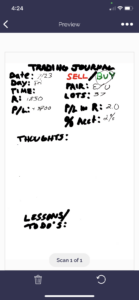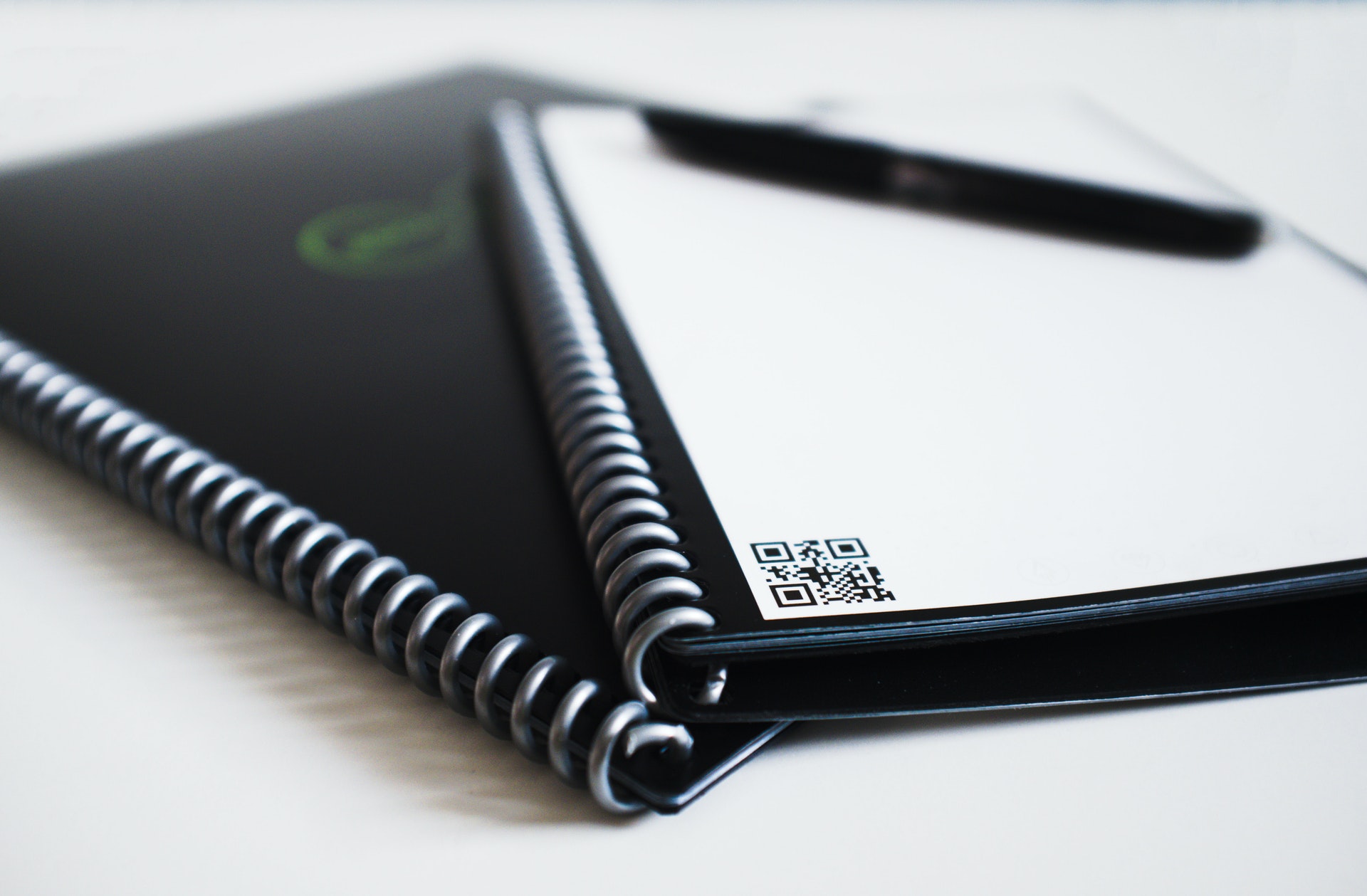For today’s tutorial, I want to show you how you can keep a digital record of your trading while still enjoying the freedom that comes with writing a journal with pen and paper. I’m going to walk you through step-by-step how to turn a Rocketbook into a day-trading journal you can use every time you have a trading session.
I’ll be transparent and say that I am an affiliate of Rocketbook, but I want you to know that they didn’t ask me – I asked them to become an affiliate because I absolutely love my Rocketbook and I want to help others find convenient ways to use it in their day trading, as well. All good?
Let’s Dive in!
What is Rocketbook?
First, what is a Rocketbook? Some of you might not be familiar with Rocketbook.
The company launched a little over five years ago and came out with an early version of a notebook that you could write on, microwave to wash it off, and reuse it endlessly.
Since then, they’ve updated their products to use special ink from the Frixion line of pilot pens and added designer paper that can be wiped clean with a spritz of water and a swipe of a towel.
 Rocketbook has an app that lets you take a screenshot of your page and send it to one of the destinations you link to the symbols on the pages.
Rocketbook has an app that lets you take a screenshot of your page and send it to one of the destinations you link to the symbols on the pages.
For example, you can send it to a file in your Google Drive, Dropbox, Evernote, among others, or even have it sent to your email.
Handwriting recognition software can also translate your printed copy into a typed digital one.
You can find out about more features by checking the Rocketbook website
I personally own the Rocketbook fusion, which I like to use for what I call “brain droppings.” You know, all of those notes you need to write down when you’re on the go.
And just recently, I started using my Rocketbook for day trading.
Why is Rocketbook a Good Solution for Keeping a Trading Journal?
So, why would you want to use Rocketbook as a trading journal?
There are a few ways I’ve kept trading journals in the past.
- At first, I had a physical notebook but I’d often get lazy and not write out all of the important details each time because I had to write a new template every session. Sometimes I’m not at home when I trade, so I wouldn’t always have my journal on me, since it was kind of bulky and added extra weight.
- I tried keeping an electronic document for a while but found that I didn’t like this setup either. I genuinely like the feel of paper and pen. I know that I look like I’m 18, but I actually just turned 30 this year and never owned a smartphone or laptop until I was in college. I still really enjoy the feeling of handwriting and I believe I remember more of what I write than what I type. Also, I tend to stay more engaged when I’m writing than when I’m typing.
- So For the last year or so, I found a solution through using an iPad and pencil and keeping a journal through a new document on the app Goodnotes. This works really well for my needs, but I still ran into issues when my pencil or the iPad when they would lose battery and I’d be left without a journal for the trading session.
But now I think I’ve found my ultimate answer to this conundrum.
The ROCKETBOOK FUSION.
Using a permanent marker, I could create a template for my day trading journal on one of the page layouts. Then, when I’m trading, I can write what I need to record by hand, and after the session, I can upload it through the Rocketbook app so the entry is saved on my google drive. Then, I can wipe it clean and have it ready to use for the next trading session.
How to Turn Your Rocketbook into a Day Trading Journal
Here’s What you need: a Rocketbook Fusion set, black and/or colored Sharpies, a blank piece of paper, and a pencil. (Optional: a ruler)
First, brainstorm what kind of information you want to record in your trading journal.
You may want to add or keep off more information depending on how many pages you want to dedicate to your journal template. I only want to capture and upload one page per trade, so I’m going to stick to the necessary information I’ll need to properly review my trades at the end of the week.
So what’s the most important stats we should record for our trades?
For me, this looks like writing down the date, day of the week, time of the trade. Whether it’s a short or long, how much money is risked, how many lots were bought or sold, as well as the profit and loss and overall percentage of account gained or loss.
But most importantly, I want to be sure to include a good amount of space to write out my thoughts, feelings, and ideas that come to mind while I trade.
This is the kind of information that you’ll want to regularly review in order to improve your trading discipline and strategies. I’m going to want to split these into different sections, one for recording my thoughts intratrade, and one for any ideas or follow-up tasks I should consider doing after the trade.
When I go over my trading journal at the end of the week, I want to be able to add any tasks to my planner from this section that I can work on over the weekend or the following week.
Next, depending on how much you trust your writing and design skills, you’ll probably want to test out what your format could look like by taking a sheet of paper and outlining the size of the Rocketbook page.
For the Fusion, the dimensions are “5.25 by “8.6” inches. Then, with a pencil or pen, you can map out some possible designs that would meet your needs.
Then, pick a page that you want to use for your template.
Once you create this template, you won’t be able to wipe it off again, so be sure you’re okay with allocating this page to just your trading journal.
I personally like the dotted graph pages best, but you could also do this on a ruled page, too. Also, decide what color sharpies you need, if you like to add color. I like to use a red and green for my short and long options and a blue for my long-form journal sections to help visually organize the page.
Plot an outline on the Rocketbook sheet with a pencil
For those of you who are gifted with great penmanship and drawing skills, you won’t have any problem here, but for yours truly, I’m going to need to put down a pencil layer first and be sure to take my time. You’re going to recreate your template on the Rocketbook page.
Once this is done, it can’t be removed, so take your time to make it look as clean as you like!
Lastly, let’s put this baby to use.
Be sure to have your Rocketbook, Fuxion pens, some water, and towel ready when you start your trading session. Record as you go and be sure to avoid using any other pens with the Rocketbook than the Fuxion ones.
Since I have a mindless habit of reaching for my pen holder, I’ll make sure my desk is perfectly clean while I trade to avoid making a mistake.
At the end of the session, you can select the preset file you want it to go to (mine is set to google drive), record your sheet with the Rocketbook app by taking a picture of the page, and once the file is uploaded, you can add any screenshots you took of your trade to this document as well.
It’s so freakin simple! And might I add, minimalistic!
So in 5 easy steps and for the same price as a fancy notebook and for 2% of the cost of an iPad, you can have your hand-written cake and digitally eat it too.
I sincerely believe the Rocketbook is one of the most underrated tech tools that can help people minimize paper waste and keep an organized, minimalistic workstation. Again, if you want to learn more or purchase a Rocketbook, feel free to use my affiliate link here. By doing so, you also help support me in my endeavor to provide you free and useful tutorials on trading discipline and forex strategies through this blog and Youtube channel.
I can’t wait to hear about how using a Rocketbook as a trading journal helps you, too.
Best of luck and see you out there in the markets!



 In fact, this foe is nipping at me as I write this.
In fact, this foe is nipping at me as I write this. You need to be able to understand these two feelings.
You need to be able to understand these two feelings.



 d how to do it, especially with the main goal of using meditation to help your trading, I’m going to share a little bit about my past with you all.
d how to do it, especially with the main goal of using meditation to help your trading, I’m going to share a little bit about my past with you all. So, when I was taking this mysticism and meditation course during college, it was the springboard I needed to dive deeper into Buddhist philosophy and practice. I found a few meditation groups in the Los Angeles area, including the Northridge Zen Center, where I was able to learn how to sit Zazen, the form of meditation taught through Zen Buddhism, and I attended dharma talks that discussed some of the Buddha’s prominent teachings about becoming an observer instead of staying in a reactionary way of thinking.
So, when I was taking this mysticism and meditation course during college, it was the springboard I needed to dive deeper into Buddhist philosophy and practice. I found a few meditation groups in the Los Angeles area, including the Northridge Zen Center, where I was able to learn how to sit Zazen, the form of meditation taught through Zen Buddhism, and I attended dharma talks that discussed some of the Buddha’s prominent teachings about becoming an observer instead of staying in a reactionary way of thinking. 
 ke profit target is almost hit but then turned the other direction. Instead of sitting in anxiety, see if you can return to your breath. Then, the next step is to mentally return to
ke profit target is almost hit but then turned the other direction. Instead of sitting in anxiety, see if you can return to your breath. Then, the next step is to mentally return to 
Latest posts